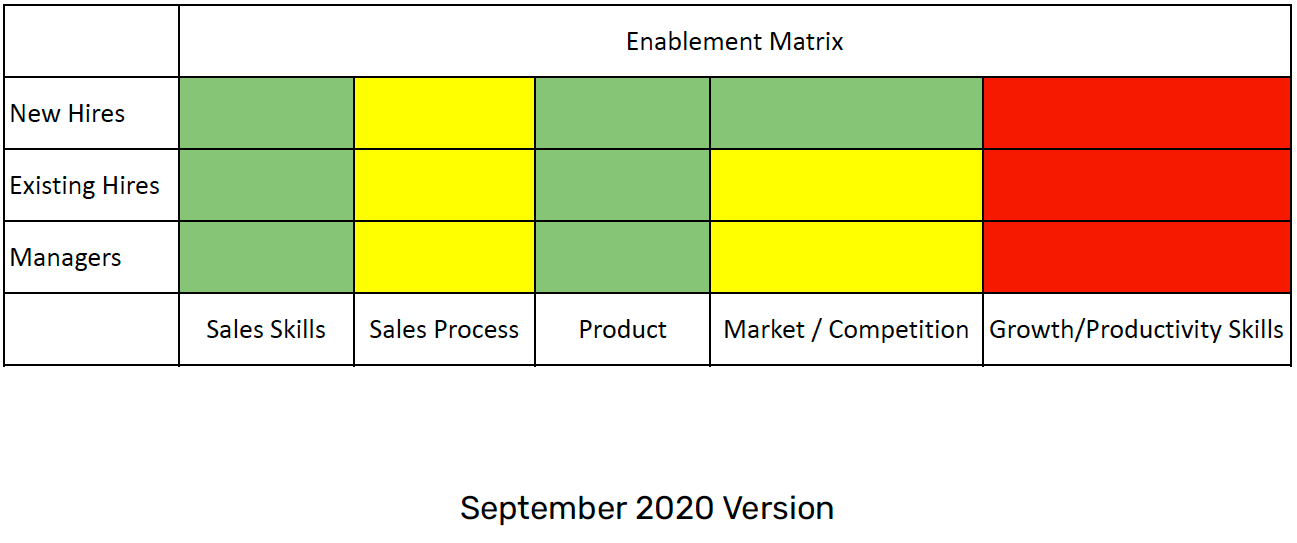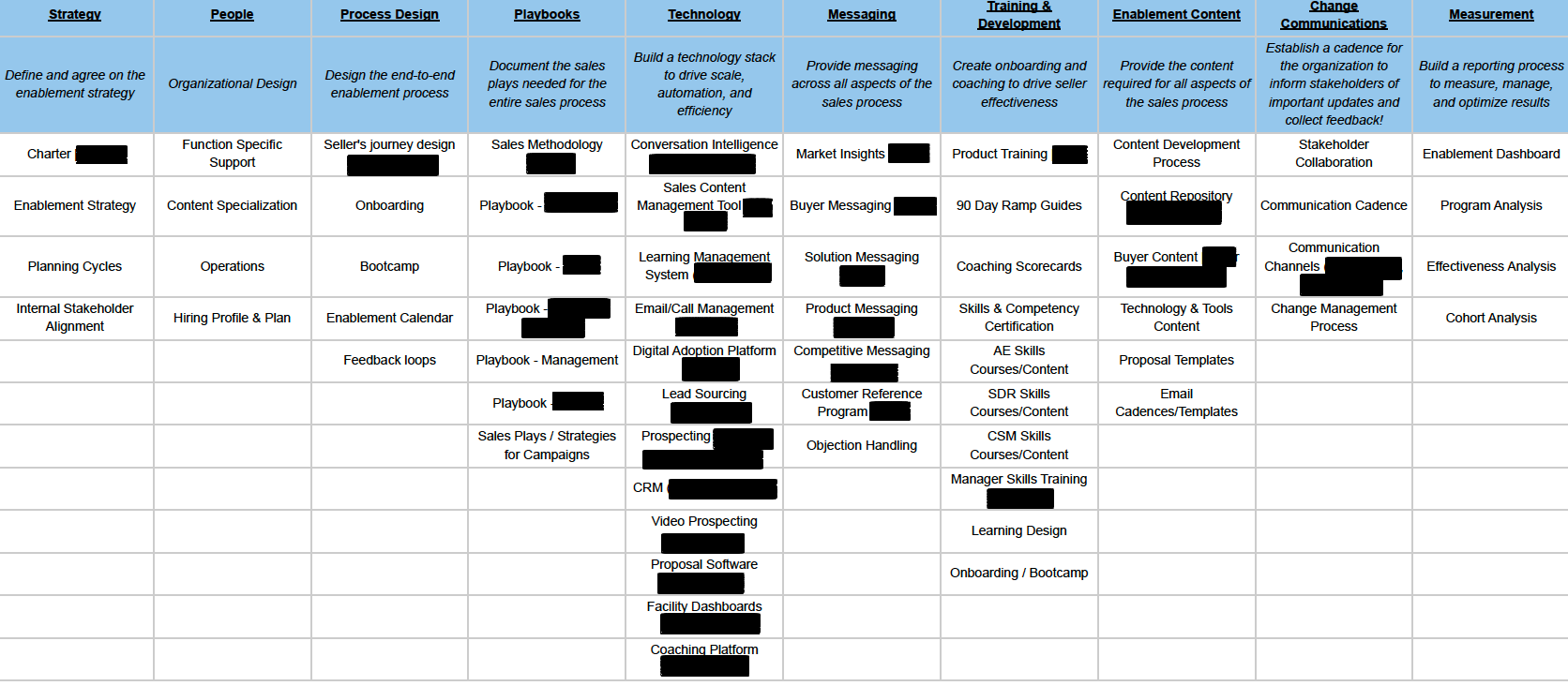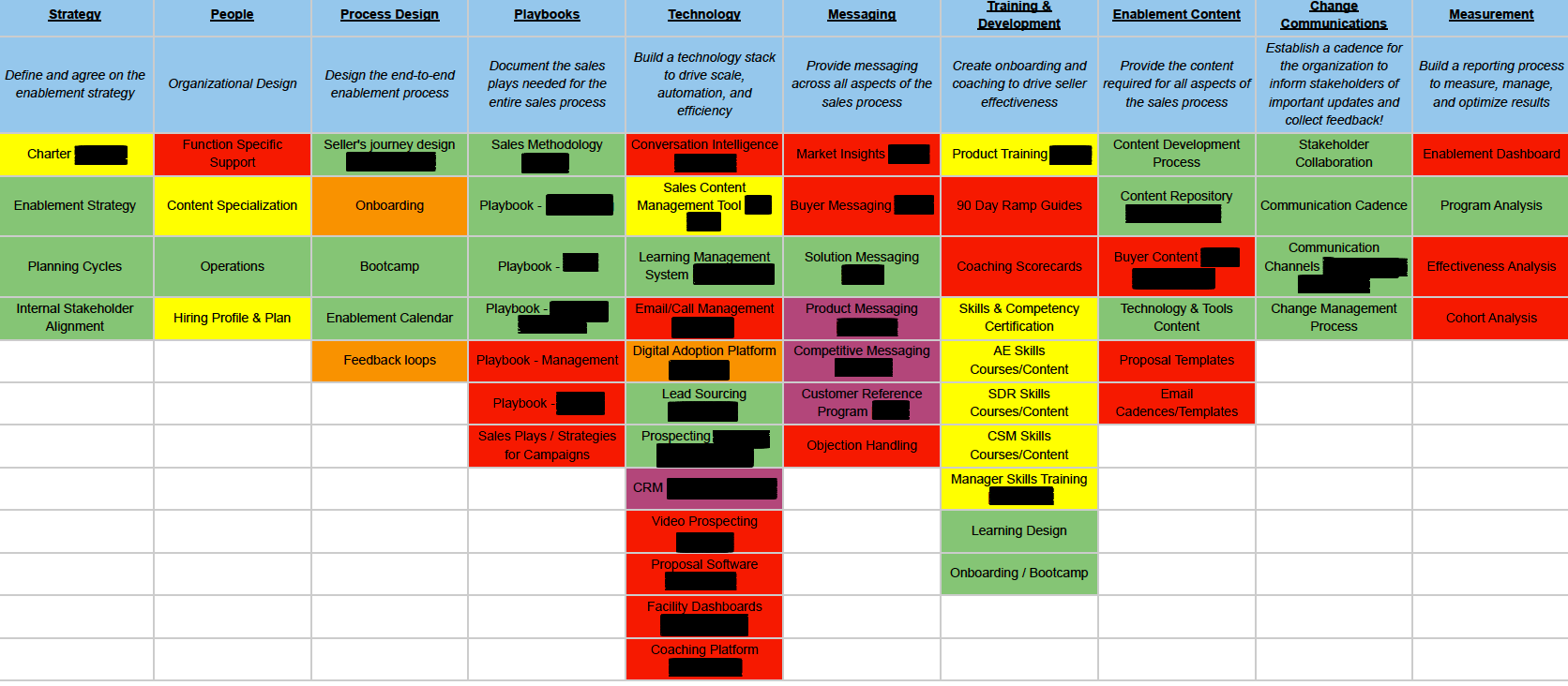My name is Thomas Cheriyan, and I am so excited to have the opportunity to share some of my experience and strategies with you, related to the strategy framework. The main aim of this article will be to establish what should be in your sales enablement playbook.
Aims for this article
In sales enablement, we're always trying to set everyone up that we work with for success, right? But what's the actual playbook for sales enablement?
I've been fortunate enough to spend a lot of time and energy reading books and networking with a lot of different peers. I'm hoping that what I share with you in this article is absolutely unique and original.
I hope it will actually change the dynamic and relationship that you have, not only with the clients that you serve, but the executive sales leadership overall.
I’m going to break down the content of this article into a few crucial talking points:
- An introduction to sales enablement
- Sales enablement in a nutshell
- What is a strategy framework?
- Why use a strategy framework?
- Solution: the sales enablement framework.
- The framework for future state
So, let's dive right in.
An introduction to sales enablement
I love sales enablement. Let me tell you why it sits at the centre of everything. See below the quote from Cory Bray.
Sales enablement is not a position in a company. It's not a job title. It's an ecosystem that crosses all functional and hierarchical boundaries.
Having a good strategy framework, and just being overall a good sales enablement leader, is going to involve working directly with sales, but also directly with marketing and HR. You’re going to be working with your IT or technology department and with the customer success team.
So, here’s where we connect the dots. Let's say what HR does relates to new hiring and onboarding. Well, that absolutely impacts sales and customer success, marketing and tech. If we can get all of these different groups and functions talking together and building a more cohesive strategy, then we're absolutely doing our job within sales enablement.
A big issue: being an order taker
Having spoken with a lot of different peers, one popular problem is that it's really easy to be an order taker. Above, you can see the popular parable of the blind people and the elephant.
You have every person feeling a different part of the elephant, and they're describing a different part of the problem. If you were to take five or ten of your sales leaders and ask each person what they think the main problem is, do you think they’d all have the same answer?
They’d all be a little different, right? Everybody would be describing a different problem. And if you have a person or a leader saying they need something done, it's really easy to simply become an order taker. A recurring theme throughout this article is being proactive versus being reactive
Being an order taker defeats the purpose of having a sales enablement function, because sales enablement is all about having an ecosystem where we're connecting the dots from all the different players. We're identifying what the critical issue is, and we are bringing forth solutions proactively to the organization.
Sales enablement in a nutshell
Sales enablement in a nutshell? We take something from its current state, and we move it to the future state.
It's really easy to put a BandAid on a problem, but in an ideal world, when we have the budget and resources, we want to take whatever it is from that current state and move it into the future state. It's very open ended.
The critical problem: strategy, communication, buy in
So, if the goal is to go from current state to future state, here's the critical problem from a sales enablement perspective, what is our strategy? How do we communicate our strategy? If you don’t have answer to that question, you’re going to feel a lot like this:

Whatever we communicate, whatever we're trying to build together, it's not going to happen without a strategy. So, we have the critical problem, what's the critical solution?
The critical solution: get a strategy framework.
What is a strategy framework?
It’s very simple: it's a breakdown of your key goals and objectives across all dimensions.
But what’s our sales enablement strategy as it relates to onboarding, or as it relates to new hire training versus existing hire training? We need to break down each of these elements.
The second thing is, how do we visualize what's working versus what needs to be better? How does the sales enablement leader set the strategy and the top priorities based on interdependencies?
And then, last but not least, what is your current situation? Are you currently in super-hiring mode? Are you in super-growth mode? Are you looking to push existing products and services onto the market? Or do you have a new product that you're launching to market?
All of these things impact the overall strategy and what you're actually prioritizing.
Why use a strategy framework?
It changes the paradigm around. We're no longer order takers, we're now proactive. We're saying to everyone: “Hey, this is something we need you to fix or make better or implement.”
That way, you're two steps ahead of everyone else.
This is another reason why a strategy framework is good. It’s the ability to communicate, or even debate with senior leadership about what the current state of sales enablement is.
You can express where you want the future state of sales enablement to be, but it's really hard to have a debate when there's no dashboard, or nothing visual to see.
You want to be able to clearly visualize those key dependencies and requirements. As sales enablement leaders, we’re also, in essence, like project managers. We need to maximize our energy and effort.
We only have limited resources, so how do we maximize our energy and effort with the limited resources that we have to ensure a high quality output?
So, what everybody's probably dying to ask right now is:

I spoke to a few colleagues, and this is what I created.
A rough outline of a strategy framework

I'm looking at dimensions as it relates to new hires and existing hires sales. I'm bucketing things into sales skills, sales process, or product training information as it relates to the market and the competition.
It’s very visual.
I can see what's working, what needs to be better, but I'm still not capturing every single dimension and thought process that goes into sales and implementation.
So, I spoke to more people. I did a hell of a lot more research, and I came up with this:
A more detailed example

This added a lot more resolution to the sales enablement framework. Now I can have intelligent, meaningful conversations with different leaders at our company as it relates to our sales enablement strategy.
Then, we take it a step further and add some colours to it:

Now I get to see what's working within enablement, as well as what we need to either improve or continue to build upon.
Everything that you’re seeing in red isn’t necessarily horrible or bad. It just means we haven't prioritized it yet. Or, we don't have the budget, the bandwidth or the resources to start tackling it.
When you share this with executives, you basically become the strongest player in the room. Why? Because you're coming to your leadership in a proactive way, giving them the ability to have a pulse on the current state of sales enablement.
Before other leaders tell you they need something done, you’re going to the business. You're emailing them and saying you’re on top of it because it's built into your framework.
Sales enablement: framework for future state
How do we go from the current state to the future state?.
This is the framework for doing that. You want to establish:
- The current or the proposed state – do a pre-mortem analysis.
- Is this a priority?
- Is it scalable?
- Is it necessary?
- Who's owning it?
- Do you have the process tech and enablement architecture to make that happen?
Understanding the current or the proposed state
When it comes to understanding the current state, the question you’re asking is, can we create a process to facilitate that?
Pre-mortem analysis
Is it scalable? One of the things you can do to make sure that it's scalable is to do a pre- mortem analysis. It sounds exactly like what it is.
The questions you’re asking are, how can this process or project absolutely fail? For example, one way that the request process could fail is if you have 1000 open opportunities, but for each of those 1000 opportunities, everyone's requesting a customer reference.
Are we able to actually facilitate introducing one customer or either one customer to one prospect or one customer to multiple prospects? There's a billion questions you can ask.
Process enablement
Once you actually start looking at it, the real critical issue is, do we need better enablement, or stronger enablement on all of our other customer programs?
Maybe we need to create more customer video content, maybe we need more customer case studies or infographics or other types of content. Maybe what we need is a customer conference.
Are we streamlining the process, or are we enabling something that's gonna create more problems and headaches once it's actually implemented?
Let's wrap up
In summary, if you don't have the time, you need to make the time.
As the graphic showed you, I spent several weeks refining, building and improving. You need to dedicate time to building. Block out time in your calendar and just focus on building the strategy framework.
The second thing is, this is not an answer guide. It's a tool. We teach our sales reps different tools all the time to help them have better stronger conversations with their prospects. This is the same thing.
This is a tool to help you to have stronger, better conversations with your internal stakeholders at your company. You need to make sure it fits your business, not mine.
Our goal here is to transform whatever is the current state of sales to the future state, with the goal of maximizing our revenue opportunities and outcomes across all stakeholders.
Thank you


